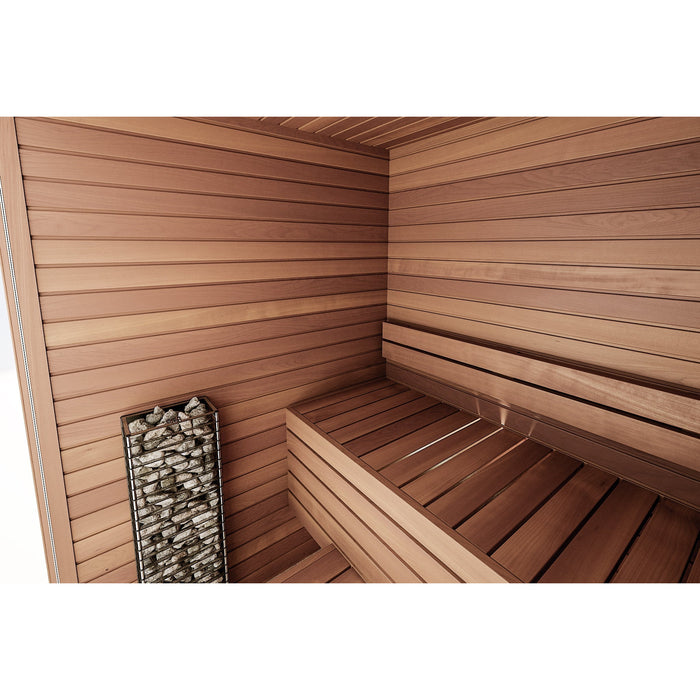The appeal of a sauna lies in its ability to provide a tranquil escape and numerous health benefits, from stress relief to improved circulation. When deciding between a dry sauna and a wet sauna, it's essential to know what sets them apart. In this post, we'll break down the core differences, benefits, and considerations for each type, helping you decide which sauna experience aligns best with your needs.
What is a Dry Sauna?
A dry sauna, often referred to as a traditional Finnish sauna, uses dry heat to create a hot environment. Here's how it works and its primary characteristics:
-
Heat Source: Dry saunas are typically heated by an electric heater or wood-burning stove, which warms up rocks that, in turn, heat the air.
-
Temperature and Humidity: Temperatures can range between 150°F and 220°F, with very low humidity levels, often below 20%.
-
Experience: The dry heat can make you sweat intensely, which is believed to help with detoxification and relaxation.

Benefits of a Dry Sauna
-
Detoxification: Sweating helps to flush out toxins from the body.
-
Improved Circulation: The heat can help to improve blood flow and reduce blood pressure.
-
Muscle Relaxation: Ideal for soothing sore muscles and joints.
-
Stress Relief: The tranquil environment promotes relaxation and mental clarity.
What is a Wet Sauna?
A wet sauna, also known as a steam sauna, utilizes steam to create a humid environment. Here’s a closer look:
-
Heat Source: Wet saunas use the same electric heaters as dry saunas, but you pour water on the heated stones to generate steam. For added convenience, you can use a water dispenser system to disperse water onto the stones at the push of a button. Additionally, the Harvia Virta Combi Electric Heater Steamer Package is specifically designed to create steam automatically.
-
Temperature and Humidity: Typically, temperatures are lower than in dry saunas, ranging from 110°F to 120°F, but with 100% humidity.
-
Experience: The moist heat can feel more intense and might be easier on the respiratory system.

Benefits of a Wet Sauna
-
Respiratory Health: The steam can help to open airways, reduce congestion, and improve breathing.
-
Skin Hydration: The moisture can hydrate the skin, leaving it feeling soft and rejuvenated.
-
Detoxification: Promotes sweating, which aids in toxin elimination.
-
Relaxation: The warm, humid environment can help reduce stress and promote relaxation.
Key Differences Between Dry and Wet Saunas
| Feature |
Dry Sauna |
Wet Sauna |
| Heat Source |
Electric heater or wood stove |
Electric heater + water on stones |
| Temperature Range |
150°F to 220°F |
110°F to 195°F |
| Humidity Level |
Low (below 20%) |
High (100%) |
| Experience |
Intense dry heat, heavy sweating |
Moist heat, easier breathing |
| Primary Benefits |
Detoxification, circulation, relaxation |
Respiratory health, skin hydration, relaxation |
Choosing the Right Sauna for You
When deciding between a dry sauna and a wet sauna, consider your personal health goals and preferences:
-
For Detoxification and Muscle Relaxation: A dry sauna might be the best choice, offering intense heat and deep sweating.
-
For Respiratory Health and Skin Benefits: A wet sauna can provide humid warmth, benefiting your respiratory system and hydrating your skin.
Frequently Asked Questions (FAQs)
Q: Can I use both types of saunas?
A: Yes, alternating between dry and wet saunas can provide a balanced wellness experience, offering the unique benefits of each.
Q: How long should I stay in the sauna?
A: It’s recommended to stay in a sauna for 15-20 minutes. Listen to your body and stay hydrated.
Q: Are there any health risks?
A: Saunas are generally safe for most people, but those with certain health conditions (like heart issues) should consult a doctor before use.
Summing Up
Understanding the differences between a dry sauna and a wet sauna can help you make an informed decision based on your wellness needs. Whether you prefer the intense heat of a dry sauna or the humid warmth of a wet sauna, both offer unique benefits that can enhance your health and relaxation. Dive into the world of saunas and find the perfect fit for your lifestyle.







Leave a comment